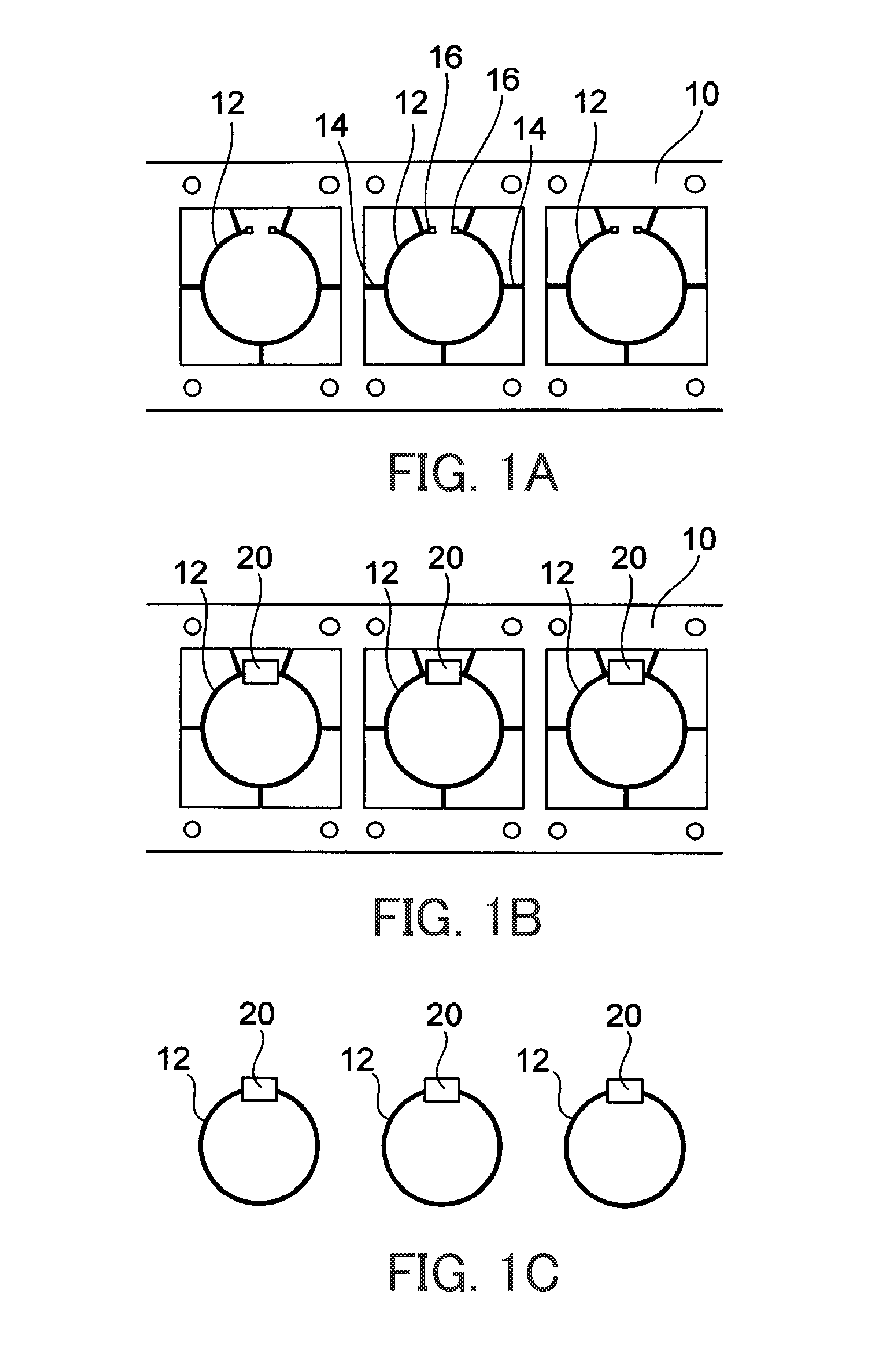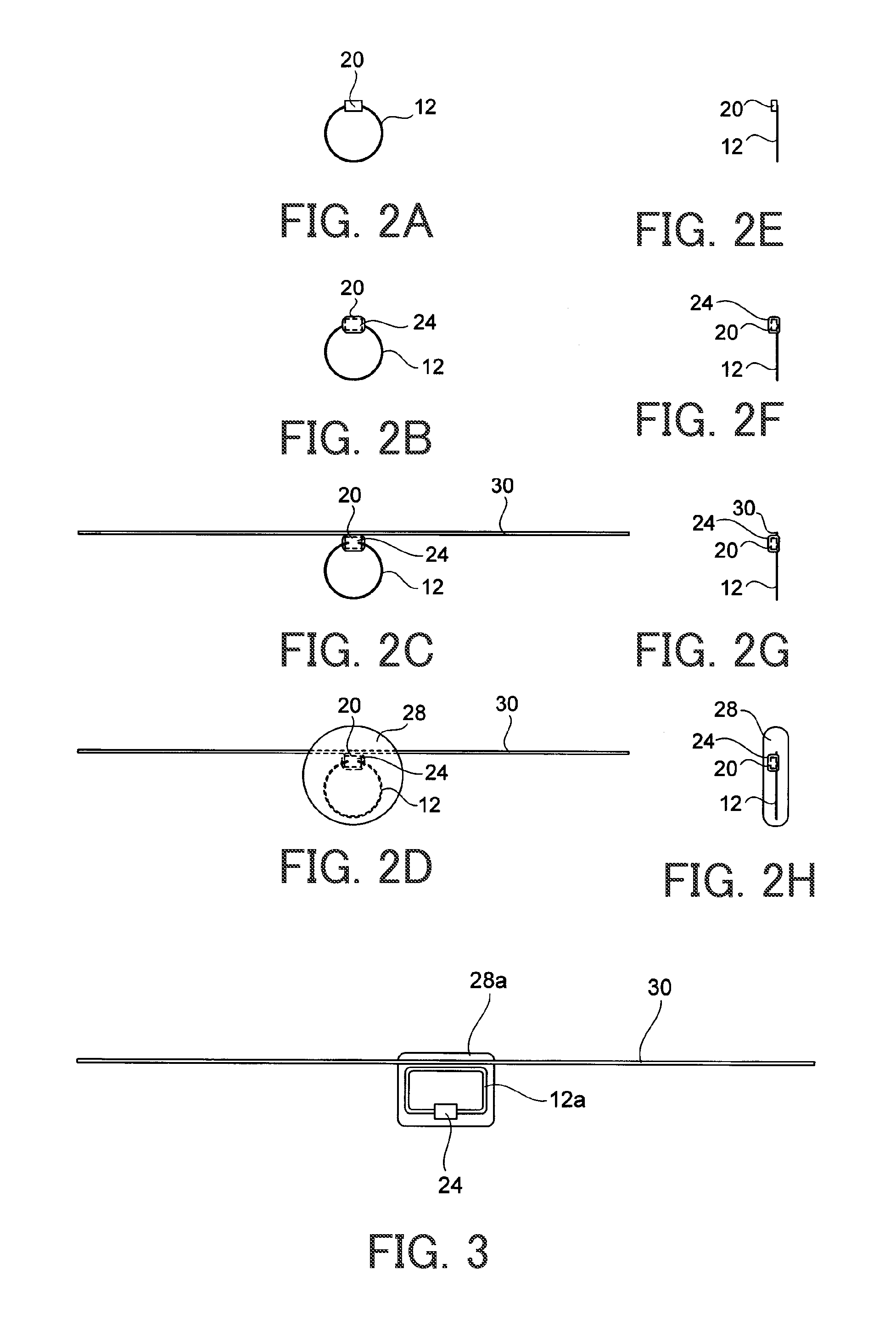RFID tag, method for producing RFID tag, and mold
a technology of rfid tags and metal antennas, which is applied in the direction of loop antennas, antenna adaptation in movable bodies, instruments, etc., can solve the problems of user strangeness, metal antennas or ic chips which are included in rfid tags, and achieve high reliability
- Summary
- Abstract
- Description
- Claims
- Application Information
AI Technical Summary
Benefits of technology
Problems solved by technology
Method used
Image
Examples
first embodiment
[0040]First of all, referring to FIGS. 1A to 1C and 2A to 2H, an RFID tag (Radio Frequency Identification Tag) and a method of manufacturing the RFID tag in the first embodiment of the present invention will be described. FIGS. 1A to 1C and 2A to 2H are manufacturing process diagrams of the RFID tag in this embodiment.
[0041]FIG. 1A illustrates a plan view of a metal strip 10 (not mounted on a semiconductor device) which is used for the RFID tag of this embodiment. The metal strip 10 is made of, for example a copper or ferrous sheet metal having a thickness of approximately 0.15 mm and is formed by stamping (pressing) or etching. The metal strip 10 includes loop antennas 12 (including micro loop antennas) each serving as an antenna of the RFID for wireless communications and terminals 16 configured to mount the semiconductor device, which is described later, to be electrically connected. Each loop antenna 12 is held by connecting portions 14. The configuration of each of the loop ant...
second embodiment
[0057]Next, an RFID tag in the second embodiment of the present invention will be described. FIGS. 4A to 4D are configuration diagrams of the RFID tag in this embodiment. FIG. 4A is a configuration diagram illustrating the inside of the RFID tag, FIG. 4B is a plan view of the RFID tag, FIG. 4C is a diagram illustrating a view as seen from the bottom of FIG. 4B (an elevation view), and FIG. 4D is a diagram illustrating a view as seen from the right side of FIG. 4B (a side view). As illustrated in FIGS. 4A to 4D, the RFID tag of this embodiment is configured such that the semiconductor device 20, as well as the main antenna 30 and the loop antenna 12, are directly and collectively sealed by using the resin 28, which is different from the RFID tag of the first embodiment in which the semiconductor device 20 is sealed with the resin 24 (the primary molding resin) and then collectively sealed with the resin 28 (the secondary molding resin).
[0058]FIG. 5 is a modification of the RFID tag i...
third embodiment
[0059]Next, an RFID tag in the third embodiment of the present invention will be described. FIGS. 6A to 6D are configuration diagrams of the RFID tag in this embodiment. FIG. 6A is a configuration diagram illustrating the inside of the RFID tag, FIG. 6B is a plan view of the RFID tag, FIG. 6C is a diagram illustrating a view as seen from the bottom of FIG. 6B (an elevation view), and FIG. 6D is a diagram illustrating a view as seen from the right side of FIG. 6B (a side view). The RFID tag of this embodiment is different from that of the second embodiment in that two through-holes 36 are formed on a resin 28b which collectively seals the main antenna 30, the loop antenna 12, and the semiconductor device 20. The formation of the through-holes on the resin 28b allows the through-holes 36 to be threaded. As a result, the RFID tag can be treated similarly to a fastening button, which makes it possible to easily attach the RFID tag to a fabric such as clothes. The main antenna 30 may be ...
PUM
| Property | Measurement | Unit |
|---|---|---|
| thickness | aaaaa | aaaaa |
| melting point | aaaaa | aaaaa |
| melting temperature | aaaaa | aaaaa |
Abstract
Description
Claims
Application Information
 Login to View More
Login to View More - R&D
- Intellectual Property
- Life Sciences
- Materials
- Tech Scout
- Unparalleled Data Quality
- Higher Quality Content
- 60% Fewer Hallucinations
Browse by: Latest US Patents, China's latest patents, Technical Efficacy Thesaurus, Application Domain, Technology Topic, Popular Technical Reports.
© 2025 PatSnap. All rights reserved.Legal|Privacy policy|Modern Slavery Act Transparency Statement|Sitemap|About US| Contact US: help@patsnap.com



